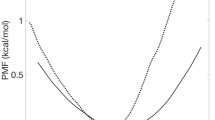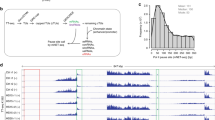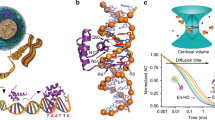Abstract
Heterodimeric transcription factors can bind to palindromic recognition elements in two opposite orientations with potentially distinct effects on transcriptional activity. We have determined the orientation of Fos–Jun binding at different AP-1 sites using a novel gel-based fluorescence resonance energy transfer assay. The orientation preference of heterodimer binding varied over a greater than 10-fold range. Single base pair substitutions that alter bending of flanking sequences reversed the orientation of heterodimer binding. Single amino acid substitutions that reduce the difference in DNA bending between Fos and Jun also reduced the orientation preference. Consequently, indirect read-out mediated by differences in DNA structure can contribute to the structural organization of nucleoprotein complexes.
This is a preview of subscription content, access via your institution
Access options
Subscribe to this journal
Receive 12 print issues and online access
$189.00 per year
only $15.75 per issue
Buy this article
- Purchase on Springer Link
- Instant access to full article PDF
Prices may be subject to local taxes which are calculated during checkout




Similar content being viewed by others
References
Rauscher, F.J.I., Sambucetti, L.C., Curran, T., Distel, R.J. & Spiegelman, B.M. Cell 52, 471–480 (1988).
Curran, T. & Franza, B.J. Cell 55, 395–397 (1988).
Glover, J.N. & Harrison, S.C. Nature 373, 257–261 (1995).
Leonard, D.A., Rajaram, N. & Kerppola, T.K. Proc. Natl. Acad. Sci. USA 94, 4913–4918 (1997).
Rajaram, N. & Kerppola, T.K. EMBO J. 16, 2917–2925 (1997).
Kerppola, T. Proc. Natl. Acad. Sci. USA 93, 10117– 10122 (1996).
Satchwell, S.C., Drew, H.R. & Travers, A.A. J. Mol. Biol. 191, 659– 675 (1986).
Gartenberg, M.R. & Crothers, D.M. Nature 333, 824–829 (1988).
Chen, L. et al. Curr. Biol. 5, 882–889 (1995).
Diebold, R.J., Rajaram, N., Leonard, D.A. & Kerppola, T.K. Proc. Natl. Acad. Sci. USA 95, 7915– 7920 (1998).
Okuda, A., Imagawa, M., Sakai, M. & Muramatsu, M. EMBO J. 9, 1131–1135 (1990).
Banerjee, C. et al. Endocrinology 137, 1991– 2000 (1996).
Tu, Z. & Anders, M.W. Biochem. Biophys. Res. Commun. 238, 285–288 ( 1997).
Chen, L., Glover, J.N., Hogan, P.G., Rao, A. & Harrison, S.C. Nature 392, 42–48 (1998).
Patel, L.R., Curran, T. & Kerppola, T.K. Proc. Natl. Acad. Sci. USA 91, 7360–7364 (1994).
Author information
Authors and Affiliations
Corresponding author
Rights and permissions
About this article
Cite this article
Leonard, D., Kerppola, T. DNA bending determines Fos–Jun heterodimer orientation . Nat Struct Mol Biol 5, 877–881 (1998). https://doi.org/10.1038/2316
Received:
Accepted:
Issue Date:
DOI: https://doi.org/10.1038/2316



